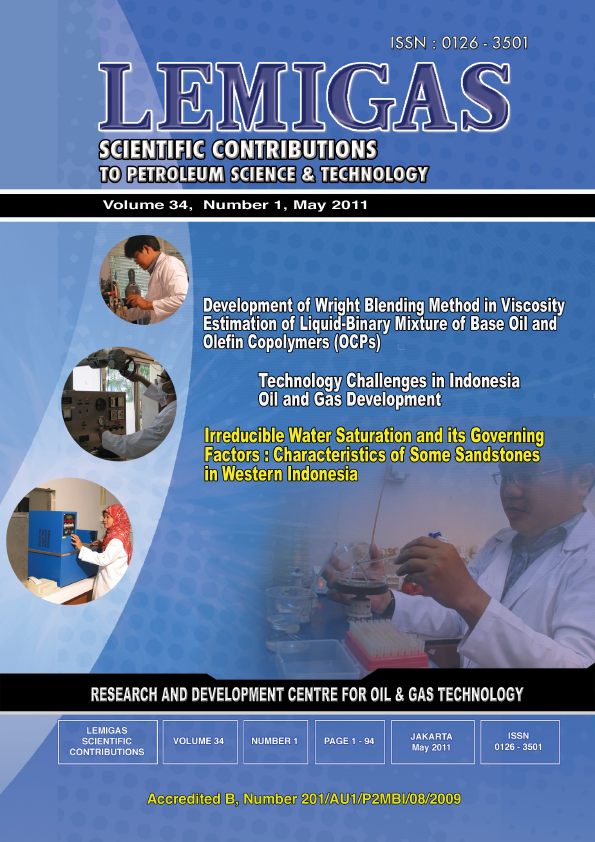Reduction Of Bacteria Cells Viability In Injection Water By Using Ammonium Chloride
DOI:
https://doi.org/10.29017/SCOG.34.1.789Keywords:
biocide, injection water, viability, antibacterial, bacteriocidal, bacteria cellAbstract
Ammonium chloride is one of the biocides used to reduce viability of bacterial cells in produced water from oil wells that will be applied as injection water. The advantage of this biocide is having high epication penetrate the cell wall, causing death of bacteria cells (bacteriocidal). Tests for antibacterial activity was done by using the API RP-38 method by adding ammonium chloride into the produced water to obtain the final concentrations of 4, 8, 16, 32, 64, and 128 mg/L. Laboratory test results showed that giving ammonium chloride at a concentration of 64 mg/L can significantly reduced the viability of bacterial cells, including groups of aerobic and anaerobic bacteria.
References
API RP-38, 1982, Recommended Practice for
Biological Analysis of Subsurface Injection Waters,
America Petroleum Institute.
Cords, B.R., Burnett S.L., Hilgren J., Finley,
M. and Magnuson, J., 2005, Sanitizers: Halogens,
Surface-Active Agents, and Peroxides on
Antimicrobials in Food, Third Edition, Edited by
Davidson, P.M., Sofos, J.N., and Branen ,A.I.,
CRC Press.
Davies, M. and Scott, P.J.B, 2006, Oilfield Water
Technology, NACE International, Texas.
Ekins, P., Vanner, R., and Firebrace, J, 2007,
Zero Emmisions of Oil in Water from Offshore
Oil and Gas Installations: Economic and Environmental
Implications, Journal of Clean Product 15.
Holt, J.G., Krieg N.R., Sneath, P.H.A., Staley
J.T. and Williams, S.T., 1994, Bergey’s Manual
of Determinative Bacteriology, Ninth Edition,
Williams & Wilkins, Baltimore, Maryland, USA.
Lee, P.S. 2009, Quantitation of Microorganisms
on Practical Handbook of Microbiology, Second
Edition, Edited by Goldman, E. and Green, L.H,
CRC Press.
Lu, M., Zhang, Z. Yu, W., and Zhu, W. 2009,
Biological Treatment of Oilfield-produced Water:
A Field Pilot Study, Journal of International
Biodeterioration & Biodegradation, No. 63.
Sayegh, A., Carew, J. and Hashem, A. 2001,
Evaluation of Oilfield Chemical for Secondary Oil
Recovery in Kuwait, Journal of Anti Corrosion
Methods and Materials, No. 48.
Wang, X, Du, Y. Luo, J. Yang J. Wang. W.,
and Kennedy, J.F., 2009, A Novel Biopolymer/
Rectorite Nanocomposite with Antimicrobial Activity,
Journal of Carbohydrate Polymers, No.
7 . ˇ
Downloads
Issue
Section
License
Copyright (c) 1970 SCIENTIFIC CONTRIBUTIONS OIL AND GAS (SCOG)

This work is licensed under a Creative Commons Attribution 4.0 International License.
Authors are free to Share — copy and redistribute the material in any medium or format for any purpose, even commercially Adapt — remix, transform, and build upon the material for any purpose, even commercially.
The licensor cannot revoke these freedoms as long as you follow the license terms, under the following terms Attribution — You must give appropriate credit , provide a link to the license, and indicate if changes were made . You may do so in any reasonable manner, but not in any way that suggests the licensor endorses you or your use.
No additional restrictions — You may not apply legal terms or technological measures that legally restrict others from doing anything the license permits.














